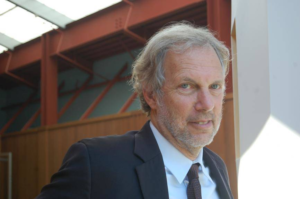There Is A Problem With The Infrastructure And Budget Bills — They’re Too Small
No Comments yetThe United States is an outlier among advanced democratic countries in terms of societal well-being. In the 2020 Social Progress Index rankings, the U.S. is 28th, in the lower half of the second tier of nations, behind economic powerhouses Cyprus and Greece. The countries that perform best in the societal well-being index adhere to the social democratic model and have strong labor unions and a long tradition of left-wing parties.
The dismal performance of the United States in well-being, which includes having dilapidated and uneven infrastructure, could change in the next few years if the Democrats manage to get their act together and pass the infrastructure and reconciliation bills. These pieces of legislation, although hardly adequate in terms of size to address the country’s urgent needs, would be undoubtedly a step forward in terms of changing the federal government’s priorities, according to Robert Pollin, distinguished professor of economics and co-director of the Political Economy Research Institute at the University of Massachusetts at Amherst. But we have to see whether the so-called U.S. “moderates” (who would be seen as right-wingers in the European political spectrum) inside the Democratic Party can put the interests of the people ahead of those of big business, or whether the so-called “progressives” (who would be seen as “moderates” in most European multi-party systems) will even back the infrastructure bill if the accompanying spending bill fails to get the necessary support. In U.S. politics, change rarely, if ever, comes from the top.
C.J. Polychroniou: After decades of political inaction on a dangerously overstretched infrastructure which lags far behind those of most other advanced countries, the U.S. Senate has finally approved a bipartisan $1 trillion infrastructure package which is on a path to final passage in the House. Lawmakers have also agreed to a $3.5 trillion budget process, although its status remains less certain as some moderate Senate Democrats find the total size of the budget to be too large. But let us first discuss the infrastructure bill whose current proposal targets spending over a five-year period. First, how does the world’s leading economy end up with such poor infrastructure, and what can we expect to be the economic impact of the infrastructure bill?
Robert Pollin: Let’s first be clear on the actual size of the bipartisan infrastructure bill. In fact, the version of the bill that passed in the Senate on August 10 allocates $550 billion over 5 years for the infrastructure investments, not $1 trillion, as widely reported. The bill mostly supports investments in traditional infrastructure areas, such as roads, bridges, airports, rail, ports, water management and the electric grid. It does also provide funds, if to a generally lesser extent, to high-speed internet, public transportation, electric vehicles and charging stations, and climate resilience.
Of course, the total price tag sounds gigantic, but in fact it is quite small, along multiple dimensions. First of all, spread over five years, the total spending averages to $110 billion per year. That is equal to less than one-half of one percent of current overall U.S. economic activity — i.e., U.S. Gross Domestic Product (GDP). In addition, this overall level of spending on upgrading the U.S. infrastructure falls far below what objective analysts have concluded is necessary to bring U.S. infrastructure up to a reasonable level. Specifically, the American Society of Civil Engineers recently concluded that the U.S. would need to spend an average of $260 billion per year for 10 years to bring the U.S. only up to a “B” level of infrastructure quality from its current “C-“ level. So the bipartisan bill provides only about 40 percent of what the leading professional society of civil engineers says is needed for the U.S. to maintain an adequate infrastructure in traditional areas. Without the full funding in the range of $260 billion per year, the civil engineers anticipate the U.S. infrastructure continuing its longstanding pattern of deterioration. Beyond that, this bill also provides only miniscule amounts relative to what is needed to advance a viable U.S. climate stabilization project.
The U.S. infrastructure today is in poor condition today for the simple reason that under 40 years of neoliberalism, the idea of undertaking major public investments in strengthening the domestic economy was pushed to the bottom of the federal government’s priorities. Virtually all Republican members of Congress have been doing this pushing, with enough congressional Democrats following along, regardless of whether a Democrat or Republican was in the White House. The top priorities of these members of Congress have been cutting taxes for the rich and continuing to expand the massive military budget. The military budget for 2021, at $704 billion, is nearly 7 times greater than what would be allocated for all the infrastructure projects if the bipartisan bill were to pass. Passing this bill is certainly preferable than having no new support for infrastructure projects. It will also have a modest positive impact on jobs. But let’s also be clear that this level of funding will produce none of the pressures on the federal budget or on inflation, as is being charged by critics. The funding level is just too small for that.
The $3.5 trillion budget package, if enacted, will be a huge step toward a progressive reshaping of the federal government. It will be “the most consequential legislation for working people since the New Deal,” according to Bernie Sanders, while it will also help to combat the climate crisis. Still, is the size of the reconciliation bill big enough to address the damage that 40 years of neoliberal policies have had on working people, the economy and our climate?
The $3.5 trillion bill goes far beyond the $550 billion bipartisan infrastructure bill in critical ways. First of all, obviously, just in terms of its size. This bill also devotes significant levels of funds to build a clean energy economy and stabilizing the climate. It also provides significant support in the areas of elder and child care, health care and housing. So let’s call it the climate and social infrastructure bill. But the fact is that even this $3.5 trillion proposal is not large relative to the size of the U.S. economy, much less relative to the country’s pressing needs, both in terms of climate stabilization and advancing social justice. In other words, I don’t agree with Bernie Sanders’s assessment as to the historic magnitude of this bill as it is currently written. I certainly have a great deal of respect for what Bernie is trying to accomplish with this climate and social infrastructure bill. I wish I could agree with his assessment.
Here are the basics: The $3.5 trillion in spending would be spread over 10 years. So that gets us to $350 billion per year. Once again, the number sounds gigantic. But it amounts to about 1.5 percent of current U.S. GDP. About one-third of the total funding is devoted to fighting climate change — let’s say around $120 billion per year. That would be a huge boost relative to the paltry amounts being spent now by the federal government on what is, ever more obviously, an existential ecological crisis. But, in my view, it amounts to only about 25 percent of the $500 billion per year that is needed to have a chance of reducing CO2 emissions in the U.S. economy by 50 percent as of 2030. In terms of a climate stabilization project, we would therefore still need to find around $400 billion per year to build a clean energy economy. These funds would be separate from support needed to create much greater resiliency in the face of the increasingly severe climate disasters — i.e., the floods, wildfires, droughts and heat extremes that are now part of the everyday global news cycle. It would also be separate from the funding needed to provide a just transition for workers and communities that are now dependent on the fossil fuel industry.
The additional investment levels needed to create a zero-emissions energy system funding could possibly come from private investors, but realistically, only if the federal government enacts stringent regulations through which the fossil fuel industry is truly phased out over the next 20 to 30 years. So far at least, I am not aware of any federal initiative to impose any such stringent regulations, such as requiring that all fossil fuel companies cut their production and sales of oil, coal and natural gas by, say, 5 percent per year, every year, or face criminal liability.
In terms of other categories of spending, such as child and elder care, the climate and social infrastructure bill is a major breakthrough in recognizing these areas as vital to improving people’s lives and creating a decent society. For example, this bill would support client-employed provider programs in the area of elder care, through which elderly people in need of care are able to stay in their homes and hire the home-based provider of their choice. Adult children, spouses, other family members, neighbors and friends would be eligible to be hired under this type of program. As it is, at present, most hours of elder care support are provided by family and friends on a voluntary basis. Providing financial support for a client-employed provider program would enable these voluntary providers to be paid for at least some of the hours of work they now provide voluntarily. These family members and friends would then be better able to concentrate their paid working hours on care provision, rather than having to also be employed at separate paid jobs in order to earn sufficient income.
The problem with the bill, at 1.5 percent of GDP per year for 10 years, is that the funding level, again, is too small. In fact, we have right now an important benchmark against which to compare this climate and social infrastructure bill. This is the THRIVE Act, which is a bill introduced in Congress in April 2021, aiming to “Transform, Heal and Renew by Investing in a Vibrant Economy” — i.e., THRIVE — through a range of investments to rebuild the U.S. economy. The THRIVE Act was the work of the national Green New Deal Network, a coalition of 15 grassroots organizations, including the Center for Popular Democracy, Climate Justice Alliance, Grassroots Global Justice Alliance, Greenpeace, Indigenous Environmental Network, Indivisible, Movement for Black Lives, MoveOn, People’s Action, Right To The City Alliance, Service Employees International Union, Sierra Club, Sunrise Movement, US Climate Action Network, and the Working Families Party. The THRIVE Act was introduced in Congress by Sen. Ed Markey of Massachusetts and Congresswoman Debbie Dingell of Michigan.
The THRIVE Act proposes to provide over $1 trillion in investments per year for 10 years — i.e., $10 trillion in total — in four major areas: clean renewable energy and energy efficiency; infrastructure; agriculture and land restoration; and the care economy, public health and the postal system. On average then, the funding levels supported by the THRIVE Act are in the range of 2-3 times larger than the combined figures for the $110 billion/year (over 5 years) infrastructure bill and the $350 billion/year (over 10 years) climate and social infrastructure bill.
To see the type of impact the THRIVE Act could have on individual communities throughout the country, consider, for example, the situation for the metropolitan area around Louisville, Kentucky. With THRIVE Act funding, solar panels could be installed on rooftops, over parking lots and on other artificial surfaces all over the city to provide over 10 percent of the area’s overall electricity demand. All public buildings could be retrofitted to raise energy efficiency levels significantly and save the city lots of money. Both the solar and building efficiency investments would contribute toward pushing down CO2 emissions in Louisville, to the point where reducing overall emissions by 50 percent as of 2030 becomes a realistic target.
In addition, there are about 10,000 elderly residents of the area who require personal care. The THRIVE Act could enable all of these people to hire whomever they wanted — family members or friends — to support them and be paid decently for some of their hours of care. The THRIVE Act would also enable Louisville to address the fact that the city has become an “urban heat island” — i.e., a city in which summer temperatures can be up to 20 degrees F hotter than nearby rural areas, creating health hazards for the city’s population. Through THRIVE, the city could follow through on plans to expand the city’s tree canopy and create cool surfaces on roads and rooftops. Still further, Louisville could invest adequately in upgrading its sewer system. The U.S. Army Corps of Engineers has assessed the area’s flood protection system to be “high risk.”
Overall, investing in these and related projects through THRIVE would generate about 15,000 jobs in Louisville and surrounding communities, equal to about 4 percent of the area’s current employment level.
The THRIVE Act would have similar impacts in all communities throughout the country. The $350 billion/year climate and social infrastructure bill could also deliver positive results in Louisville and elsewhere, but only at about one-third the level of the THRIVE Act. We then have to ask: which parts of the THRIVE Act do we sacrifice? Do we abandon the idea of advancing a climate stabilization program that has a serious chance of cutting U.S. emissions by 50 percent as of 2030? Do we give up the idea of supporting family members and friends who are providing critical elder care? Should Louisville’s summer temperatures be allowed to rise by, say, 25 degrees F relative to surrounding rural areas? And with expanding employment opportunities: should we be satisfied with creating 5,000 more jobs in Louisville when we could create 15,000 through THRIVE?
I want to emphasize again that I am not disparaging the climate and social infrastructure bill being advanced by Bernie Sanders and other Congressional Democrats. Without question, it is pushing in the right direction. But we also have to be clear-eyed as to the actual size of this measure and what its impact can be relative to the climate and social crises that we face. The grassroots activists throughout the country in the Green New Deal Network, who crafted the THRIVE Act, have established the standard that we need to be reaching for now as best we can.
Source: https://truthout.org/there-is-a-problem-with-the-infrastructure-and-budget-bills-theyre-too-small/
You May Also Like
Comments
Leave a Reply








